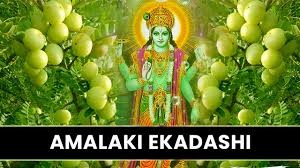
Amalaki Ekadashi 2025: Amalaki Ekadashi, observed on the Ekadashi Tithi of Falgun Shukla Paksha, holds deep spiritual and cultural significance. Falling between Mahashivratri and Holi, this Ekadashi is dedicated to Lord Vishnu and the sacred Amla tree. Observing this fast is believed to bring health, prosperity, and divine blessings. It is said that devotees who seek heaven attain a place in Indra’s abode, while those desiring salvation are blessed with a place in Vaikuntha, the celestial abode of Lord Vishnu.
This article provides detailed insights into Amalaki Ekadashi 2025, including its date, auspicious time, puja method, and why it is popularly known as Rangbhari Ekadashi.
Amalaki Ekadashi 2025: Date and Auspicious Time
In 2025, Amalaki Ekadashi will be observed on Monday, March 10. According to the Hindu calendar, the Ekadashi Tithi will begin at 7:45 AM on Sunday, March 9, and end at 7:44 AM on Monday, March 10.
As per Udaya Tithi (the tithi prevailing at sunrise), the fast will be observed on March 10, making it the most auspicious day to perform the Ekadashi Vrat and Puja. Devotees across India will observe this sacred fast on the same date.
Amalaki Ekadashi 2025: Puja Vidhi and Rituals
On Rangbhari Ekadashi, devotees offer special prayers to Lord Vishnu, Lord Shiva, and Goddess Parvati. The puja rituals include:
1. Worship of Amla Tree and Lord Vishnu
- Wake up early and take a holy bath.
- Clean the puja area and place an Amla (gooseberry) branch or tree for worship.
- Offer water, flowers, turmeric, sandalwood, incense, and diyas to the Amla tree.
- Worship Lord Vishnu by offering Tulsi leaves, yellow flowers, and bhog (prasad).
- Chant Vishnu Sahasranama and other sacred hymns to seek divine blessings.
2. Observing the Amalaki Ekadashi Fast
- Devotees observe a strict fast, refraining from grains, pulses, and certain vegetables.
- Fruits, nuts, and milk-based foods are consumed if necessary.
- Some devotees follow a nirjala vrat (waterless fast) to seek higher spiritual merit.
3. Rangbhari Ekadashi Rituals in Shiva Temples
- Special worship is conducted for Lord Shiva and Goddess Parvati on this day.
- Red gulal (vermilion powder) is offered to Lord Shiva, symbolizing his fiery form.
- Makeup items (shringar) are offered to Goddess Parvati to seek happiness and marital bliss.
- Devotees stay awake all night, singing bhajans and kirtans in praise of Lord Shiva.
- Lighting a nine-wick lamp before Lord Vishnu and keeping it burning all night is believed to bring peace and prosperity to the household.
Why is Amalaki Ekadashi Called Rangbhari Ekadashi?
Amalaki Ekadashi is also widely known as Rangbhari Ekadashi, marking the beginning of Holi celebrations. This festival is celebrated with grandeur in Kashi (Varanasi), where devotees welcome Lord Shiva and Goddess Parvati with colors, abir, and gulal.
Mythological Significance of Rangbhari Ekadashi
According to Hindu scriptures, after the divine marriage of Lord Shiva and Goddess Parvati, they arrived in Kashi for the first time on this day. The people of Kashi welcomed them by throwing colors and gulal, signifying their joy and devotion. This tradition continues even today.
Connection with Holi Celebrations
- Rangbhari Ekadashi marks the start of the Holi festival in Kashi and several parts of North India.
- From this day onward, the tradition of playing with colors continues for six days until Holi.
- Devotees believe that offering colors to Lord Shiva ensures happiness and prosperity in life.
The arrival of Lord Shiva and Goddess Parvati in Kashi is an essential part of Varanasi’s cultural heritage, making Rangbhari Ekadashi a significant festival for Shiva devotees.

 Share
Share






